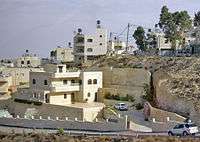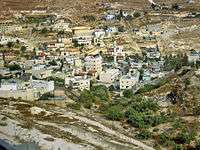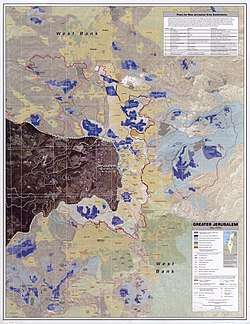Jabel Mukaber
Jabel Mukaber (Arabic: جبل مكبر, Hebrew: ג'בל מוכאבר, lit. Big Mountain) is a predominantly Palestinian neighborhood in southern East Jerusalem.[1] It is bordered by East Talpiot[2] to the west, Abu Tor and Silwan to the north and Sur Baher to the south. Jabel Mukaber has a population of approximately 30,000 (2017).[3][2]
Jabel Mukaber | |
|---|---|
Municipality type B | |
| Arabic transcription(s) | |
| • Arabic | جبل مكبر |
| • Latin | Jabal Mukaber Jabel Muqaber Jabal Mukkaber (unofficial) |
| Hebrew transcription(s) | |
| • Hebrew | ג'בל מוכאבר |
 Jabel Mukaber with the Dome of the Rock seen in the background. | |
 Jabel Mukaber Location of Jabel Mukaber within Palestine | |
| Coordinates: 31°45′16.75″N 35°14′27.65″E | |
| State | State of Palestine |
| Governorate | Jerusalem |
| Occupying state | Israel |
| Israeli district | Jerusalem District |
| Government | |
| • Type | Municipality |
| Population | |
| • Total | 16,030 |



History
According to local legend, Jabel Mukaber is named after Umar ibn al-Khattab, a disciple of Muhammad and the second caliph of the Islamic Caliphate, who cried Allahu Akbar at this site. It was substantially settled by members of the Bedouin Sawarha tribe at the turn of the 20th century.[4] During the Mandatory Palestine, the offices of the British High Commissioner, the representative of British imperial rule in Mandatory Palestine were located on the ridge of Jabel Mukaber (known as the Hill of Evil Counsel[5] in medieval Christian tradition, which identified it as the residence of Caiaphas where Judas plotted to kill Jesus).[6][7] During the 1948 Arab–Israeli War, the Egyptian Muslim Brotherhood battled Jewish forces in the area.[8] Jabel Mukaber and other Arab villages in East Jerusalem came under Jordanian control, with the division of the city formalized in the Armistice Agreement of 3 April 1949. Jordan subsequently unilaterally annexed the West Bank, a move that was largely unrecognized internationally.[9]
Post-1967
After the 1967 Six-Day War, Jabel Mukaber has been under Israeli occupation. Israel unilaterally placed six of the Jabel Mukaber's seven neighbouring villages under the jurisdiction of the Jerusalem Municipality,[10][11] The exception was ash-Sheikh Sa'd, which was detached from Jaber Mukaber, though the two villages were locally considered to be one place, and excluded from Israel's incorporation of the area with its provision that the villagers would be treated as permanent residents of Israel.[12]
According to ARIJ, Israel has confiscated the following areas of land from Jabel Mukaber in order to construct Israeli settlements:
- 544 dunams for East Talpiot,[13]
- 140 dunams for Nof Zion.[13]
Demography
Many residents of Jabel Mukaber rejected Israeli citizenship to demonstrate their solidarity with Palestinians in the West Bank,[11] but they are considered permanent residents. As holders of blue identity cards, they have wide freedom of movement within Israel, and have access to health care, unemployment and other benefits.[11][14]
The construction of the Israeli West Bank barrier has divided Jabel Mukaber in half and left some neighborhood residents on the West Bank side of the wall, meaning that they hold Palestinian IDs rather than Israeli IDs, and cannot cross into Israel itself.[15] Running through the centre of the neighbourhood, the barrier often separates members of the same family from one another, disrupting normal family life.[15] Jabel Mukaber is under-budgeted for municipal services, leading to sewage blockages in parts of the neighborhood and a shortage of classrooms.[16]
Arab-Israeli conflict
East Talpiot was established in 1970 in close proximity to Jabel Mukaber during the upswing of building that followed the Six-Day War.[14] When the Second Intifada (uprising) began, the mood changed. Since then, Jabel Mukaber has been the scene of numerous demonstrations, protests and riots in support of the Palestinian cause.[17][18]
The Jerusalem Municipality began to draw up a zoning plan for Jabel Mukhaber in 1980. It was finally approved 16 years later, in 1996. The plan designated 70% of Jabel Mukhaber land as a green zone. The land set aside for housing construction was 20.5%, though most of it had already been used to that end. The housing density for the Arab area was set at 25%, in contrast to the 140% housing density level allowed for construction in the adjacent Jewish suburbs of East Jerusalem.[19]
Oded Shalom, writing in 2017, states that Jabel Mukaber is
'A depressing slum with garbage spilling over from dumpsters all over the streets, with no playgrounds and no green areas, with a shortage of classrooms and kindergartens, with one high school for boys which was opened only two years ago after 20-year pleadings from the residents. They pay taxes to the state and property tax to the municipality, but don’t seem to be getting anything visible in return. .'[3]
Landmarks
A Tolerance Monument sculpted by Czesław Dźwigaj in collaboration with Michal Kubiak is situated on a hill marking the divide between Jewish East Talpiot and Arab Jabel Mukaber, standing opposite the United Nations headquarters in Jerusalem in a park near Goldman Promenade. Unveiled in Jerusalem in 2008, it was funded by Polish businessman Aleksander Gudzowaty as a symbol to promote peace in the Israeli–Palestinian conflict.[20]
See also
References
- "Israel approves major settlement expansion in Palestinian neighborhood in East Jerusalem". haaretz.com. 2017-10-25. Retrieved 2019-05-31.
- Segev, Tom (1 September 2005). "A good friend jumps the fence - Haaretz.co.il". Haaretz Daily Newspaper Ltd. Retrieved 2011-07-17.
- Oded Shalom,'How Jabel Mukaber became a terror incubator,' Ynet 19 January 2017.
- Amir Cheshin,Bill Hutman,Avi Melamed, Separate and Unequal, Harvard University Press ISBN 978-0-674-02952-1 2009 p.201.
- Motti Golani, The End of the British Mandate for Palestine, 1948: The Diary of Sir Henry Gurney, Springer 2009 ISBN 978-0-230-24473-3 p.44, n.78.
- Charles Warren, Claude Reignier Conder, The Survey of Western Palestine: Jerusalem, Committee of the Palestine Exploration Fund1884 p.397
- A.B.H. Kargbo. History & Holy Places. Bait Mal al-Quds al-Sharif.
- ʻUwaysī, ʻAbd al-Fattāḥ Muḥammad. (1998). The Muslim Brothers and the Palestine Question 1928-1947 I. B. Tauris, p.209. ISBN 1-86064-214-4.
- P R Kumaraswamy, Historical Dictionary of the Arab-Israeli Conflict, Rowman & Littlefield 2015 p.161.ISBN 978-1-442-25170-0
- A good friend jumps the fence, Tom Segev, Sep.01, 2005, Haaretz
- Eric Westervelt (July 10, 2008). "Israelis Propose Laws To Punish Terrorists' Families". National Public Radio (NPR).
- René Backmann, A Wall in Palestine, Picador 2010 ISBN 978-1-429-95370-2p.123.
- Jabal al Mukabbir & As Sawahira al Gharbiya Town Profile, p. 15
- Gorenberg, Gershom (October 2, 2007). "A Note to Hillary on Jerusalem Disunited - prospect.org". The American Prospect. Retrieved 2008-09-07.
- Ghiath Nasser (17 January 2008). "Like the Berlin Wall..." Common Ground News Service. Archived from the original on 2010-12-23. Retrieved 2008-09-09.
- Sela, Neta (2006-05-23). "The Jerusalemites Israel doesn't like - ynet". ynetnews.com. Retrieved 2018-05-30.
- Zino, Aviram (16 March 2008). "Rightists hurl stones at Arab homes in Jerusalem - ynet". ynetnews.com. Retrieved 2008-09-07.
- "Israelis try to destroy attacker's house - USAtoday". Usa today. 2008-03-16. Retrieved 2008-09-07.
- Menachem Klein, Jerusalem: The Contested City, C. Hurst & Co. 2001ISBN 978-1-850-65575-6 p.30.
- Kershner, Isabel (2008-10-17). "Symbol of Peace Stands at Divide Between Troubled Jerusalem's East and West". New York Times. Retrieved 2008-10-18.
External links
- Survey of Western Palestine, Map 17: IAA, Wikimedia commons
- Jabal al Mukabbir & al Sawahreh al Gharbiyya (Fact Sheet), Applied Research Institute–Jerusalem, (ARIJ)
- Jabal al Mukabbir & As Sawahira al Gharbiya Town Profile, ARIJ
- Jabal al Mukabbir & As Sawahira al Gharbiya picture, ARIJ
- Locality Development Priorities and Needs in Jabal al Mukabbir & As Sawahira al Gharbiya, ARIJ
